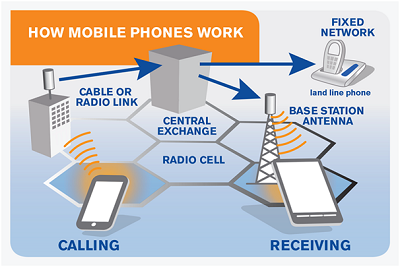Mobile Phone Technology Basics
How does a mobile work - the basics

© copyright elipt.com
- When purchased, the SIM is registered by a network with the features available to that SIM and stored in the network Home Location (HLR).
- The SIM is inserted in the mobile station (MS) and powered up.
- The MS connects to the local BSC and hence the VLE / MSC. A network registration process is executed and the MS registered on the network.
- The wireless element is the connection between the mobile phone and the mast. The communications within the rest of the network, the backhaul, is most likely fibre optic cable.
- Whilst switched on and a network is available the mobile is tracked and if necessary the control passed from one base station element to another through a process called handover.
- Mobile phones are often called cell phones. A cell is the area which is controlled by a single mast often represented by a hexhagonal cell
- A MS will be able to make or receive a call, send or receive a text, send or receive data.
- The mobile phone will have available to it a phone system (PSTN) or a data system (IP).
- The trunk or backhaul network must have the capacity to deal with all the connections made to the mast or switching centre
*u* ©mobilephonetechnology.co.uk all rights reserved 2017- 2025



